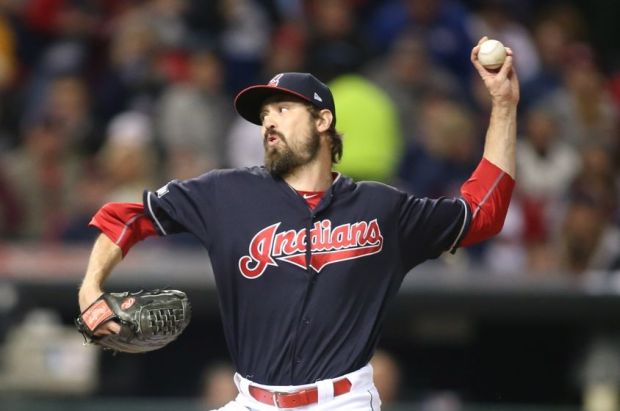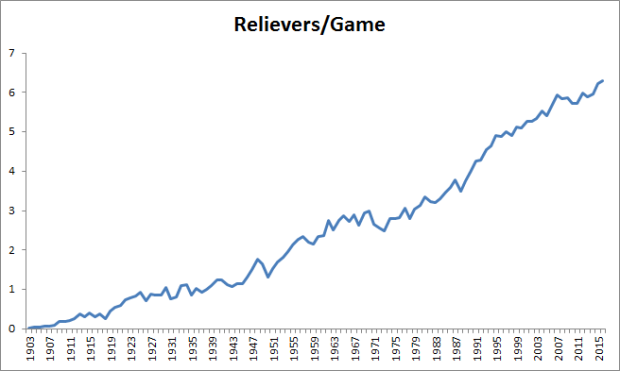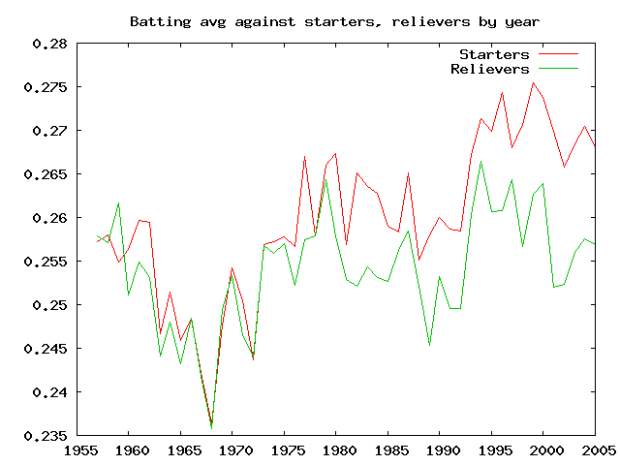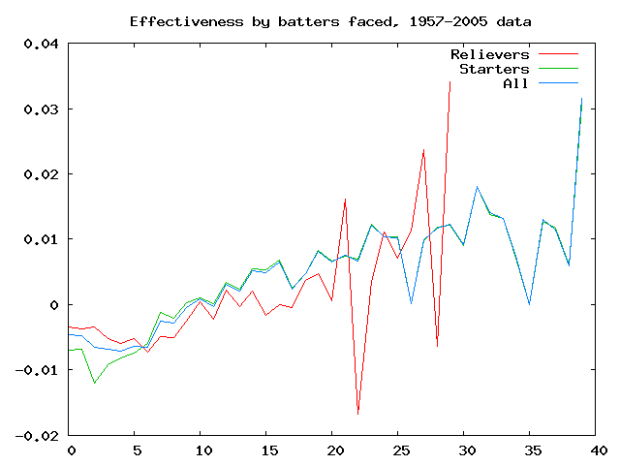-The K Zone-
December 25th, 2016

Andrew Miller, of the 2016 Postseason Indians, showed just how valuable a multi-inning reliever could be
The Relieving Future of Baseball: A Graph-ic Novel, by Ian Joffe
When reminiscing on the Dodger’s 2016 playoff run, one of the most memorable moments that comes to mind was in game National League Divisional Series against the Washington Nationals. If you need a refresher, star closer Kenley Jansen had already pitched the 7th and 8th innings, and after allowing two walks in the ninth, it seemed he was tiring out. Jansen still needed two outs, but his control was clearly fading, it was a one run game, and Dodgers’ postseason nemesis Daniel Murphy was at the plate. How did manager Dave Roberts solve this dilemma? He shocked the world, sending starting pitching ace Clayton Kershaw, perhaps the best pitcher of this generation, to the hill. Kershaw made quick work of Murphy and Wilmir Difo, to collect the save and help the team move on to play the Cubs in the NLCS.
The successful use of Kershaw the closer is an omen of a change to come in the future of baseball. As time goes by, the role of the starter in baseball will dwindle down to nothing, and relievers will dominate all nine innings of the game. The idea may sound slightly insane, but there is certainly precedent for it. MLB is always trending towards more and more reliever usage (the y-axis is the average IP of a starter, per start in the given year):

Source: http://www.vivaelbirdos.com/2014/1/13/5296618/why-the-stat-of-pitching-wins-is-obsolete-in-one-graph
This graph shows the how the use of starting pitchers has been diminished throughout the years. The trend clearly shows that starters are being hooked earlier in games, allowing relievers to take the field. The importance of relievers is further shown here:

Source: https://theringer.com/relief-pitcher-atari-closer-bullpen-f1a4b04e4084#.2mb2tfwu8
Each year, more and more relievers are utilized by teams. The trends are clear. It is very reasonable to continue these curves, and estimate that in the next few decades, the role of a starter could be only a few innings – basically making them relievers themselves. Teams continue to rely on relief pitchers more, and there is reason why they do so.
Relievers are simply more effective at getting the outs they have to get than starters. Batting average against, the measure of how well or poorly one gets outs, shows this trend:
Source: http://www.livewild.org/bb/pitchingstaff/
My apologies that the graph only goes up to 2005, but you get the idea. Since the true introduction of the reliever in the mid-late 20th century, that role has retired batters at a consistently more efficient rate. There are two main reason for this. First of all, it is generally true that as the game goes on, pitchers tire out more. 
Source: http://www.livewild.org/bb/pitchingstaff/
The y-axis is a statistic that is very similar to BAA (batting average against), but makes all pitchers and hitters equal, normalizing them to average based on their other performances over the course of the season. Aside from the first six outs or so, pitchers get less and less effective as the game goes on, and are less able to perform the most necessary task of baseball: creating outs. However, over the first five batters or so, which is about how long a reliever is expected to pitch for, there is little to no regression. Overall, pitchers tire out over the course of the game, but are okay for the first five batters or so. The other reason why starters have higher ERAs than relievers is that pitchers get worse each time they see a certain hitter.
| Times Through Lineup | Opp. wOBA, adjusted to player quality |
| 1 | .340 |
| 2 | .350 |
| 3 | .359 |
Source: http://www.baseballprospectus.com/article.php?articleid=22156
The chart shows the relationship between the number of times a pitcher has gone through the batting order and their opposing wOBA (a statistic similar to, but more accurate than SLG%), after it is adjusted to the fact that pitchers tire out, plus batter quality increases later in the game. It is a clear pattern that each time a pitcher faces a batter, they get worse. Starters will face each batter twice, three times, or more, while relievers may only face each batter once. This is just another reason why short-term pitchers are more effective than long-term pitchers.
Thus, the trends are justified. They show that the future of the game is dominated by relievers, and there is reason why this would happen: the nature of the relief pitcher is better than the nature of the starter. There is just one obstacle blocking this trend: value. Today’s sabermetric front offices are looking for players that can give the most productivity for what they are paid. It would be difficult for a reliever, who may pitch two or three innings every five days, to match a starter who might pitch six innings, over the same period of time. This is why, to fit the trends, the role of the reliever must change.
This postseason, pitchers like Andrew Miller, Aroldis Chapman, and Kenley Jansen filled larger roles than just their usual one inning. They put together outings of 5, 6, and 7 outs. Through outings like those, relievers will achieve values close to or above those of starters. When I look into the crystal orb for MLB, I see teams holding two sets of 4-5 pitchers, who will each throw about two innings, or about 6-9 batters, every other day. The rest of the pitching staff (2-4 pitchers, if a team carries 12 on their roster) can be used as depth in case a usual pitcher is having a rough outing, someone gets hurt, or the game goes into extra innings.
In this reality, pitchers throw about 160 inning each year. This is nearly as much as a starter, and will therefore come at much better value, as starters are paid far more than relievers:
Source: http://www.businessinsider.com/chart-mlbs-highest-paid-positions-2014-7
Top relievers and closers make about the least amount of money compared to other positions, especially starters, who make the most. This data set was put together in 2014, before deals like Chapman’s $86MM, Jansen’s $80MM, and Melancon’s $62MM, so relievers and starters will likely be paid a bit more now, but so will all the other positions. In general, relievers are paid very little compared to starters, and if relievers are pitching nearly as many innings, that means they will be a relative bargain. Additionally, at least from my fantasy mindset, the reliever closer markets have relative depth. Last year, I was able to pick up most of my staff after pick #100, and I plan to do the same this season. That means teams should not have to pay top dollar to get a valuable relief pitcher.
As a final value point, relievers are far less likely to have to go under the knife than starters. In an interview with Grantland (Source: http://grantland.com/the-triangle/tommy-john-epidemic-elbow-surgery-glenn-fleisig-yu-darvish/), baseball doctor Glenn Fleising said:
“Pitchers, especially those who on the younger side, are far more likely to get hurt if they throw more than 80 pitches per appearance.”
Relievers, especially in my two-inning system, would rarely throw 80 pitches. It is extremely important for players to be able to be able to stay on the field, especially in this day and age of seemingly constant injuries. It is highly valuable for players to be producing as often as they can, meaning not constantly breaking their bodies. Lack of injuries is all the more reason to increase the value of relief pitchers. It is arguable that if we start to force relievers to throw triple innings per season, it will make them more likely to be hurt. But, what if we took starters, and decreased their workload from 200 to 160 innings. In the future of baseball, players will be trained throughout their whole professional career to throw their 160 innings, to account for the benefits of relief pitching and value/productivity. Those who are trained to be starters are able to go 200 innings per year, so if on is trained to pitch 160 innings per year, they will able to do so. The future of MLB is certainly a relieving one.
Check out my debate with Mike over the Dodgers next second baseman, my piece about the Royal’s big mistake, or an interview with Zach Eflin.
Many thanks to my data sources! I recommend that you guys click those links and read the articles, many are extremely good.
Image Attribuitions:
http://keepingitheel.com/2016/10/20/heels-mlb-clevelanddians-pitcher-andrew-miller-mvp-2016-alcs-in/


To execute it….you would need 6.. 2 inning guys.
Guys 123 go on tuesday
Guys 456 go on wednesday
Guys 123 go on thursday
Guys 456 go on friday
And 4 middle relievers *(preferably 2 lefties 2 righties)
And a closer
And at least 2 swing/long relievers -(you need these guys for mop up duty when the score is 8 to 2 / 7 to 1 / 9 to 2 whatever…..whether winning or losing you still dont want to waste pitches from your best guys in those situations
Thats 13. And maybe it could work……but i think you would see your 2 inning guys wear down way quicker than you expect. A guy like aroldis chapman can throw 100 for 13 pitches but put him out there for three innings….you see what happened in world series. Same would happen if you tru to have the same 6 guys pitching 2 innings every day or every other day. It woukd be fine in april and may but by end of august….the would be sporting 5.78eras and. DL TRIPS
LikeLike
You do have a good point, very worthy of consideration. I still think that between four two-inning guys and a few spares, you should be able to cover yourself game to game and not have guys tire out too much over the season (they are still pitching less than a starter would). However, you are right that it would work much better with a larger roster. I actually thought that would happen in the new CBA (at least one more player) but, of course, that won’t be happening (https://thekzonenews.wordpress.com/2016/11/30/details-on-new-mlb-collective-bargaining-agreement/). Anyways, thanks for the feedback, I love it when people weight in!
LikeLike
I think your idea has merit – but it’s very hard to execute with a 25 man roster – which is not something you included as a potential road block to success with this plan.
What i mean is the manager would need at least 11-12 hitters, especially in an NL team where he wants to pinch hit for his pitcher spot. (If your plan were executed – it would create more offense with many more pinch hit oppurtunities per game)
But that means the pitching coach would have a max of 12-13 pitchers – and they each need days rest between appearances –
And you cannot just move guys up and down from the minors when they are tired because they run out of options.
There are some teams who have pushed for a 26 or 27th roster spot – but I have never heard traction to that actually happening.
LikeLike